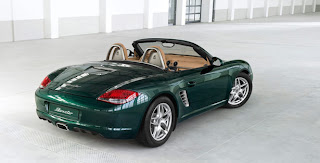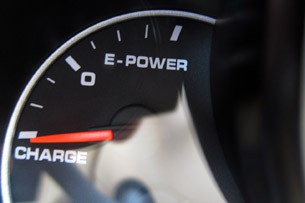What's New for 2010
The 2010 Porsche Panamera is an all-new performance luxury sedan.Introduction
It's not every year we get an all-new Porsche model, let alone a four-door that literally breaks the mold for cars bearing that iconic red, black and gold crest. Porsche toyed with the idea of a four-door 911 for years, but the prospect of a more practical, everyday version of the world's most iconic sports car never materialized. The 2010 Porsche Panamera isn't a four-door 911 -- the engine's in the front, for one thing -- but the 911's spirit is alive and kicking in this remarkable luxury sedan that's just as happy carving up a winding back road as it is cruising down the interstate.The Panamera is built on a new platform and has a wheelbase that's a bit longer than traditional midsizers like the BMW 5 Series and Mercedes E-Class but shorter than those of larger sedans like the 7 Series and S-Class. At 76 inches wide, the Panamera's got more girth than all of them, but its 55.8-inch height makes it the Tom Cruise of the cast.
This is one undeniably sleek and sporty automobile. Yet that low stance doesn't mean passengers are treated to a claustrophobic cabin unfriendly to those blessed with height or grand coiffures. On the contrary, the front compartment is eminently accommodating, and the two-person backseat has head- and legroom to spare. Moreover, those rear bucket seats can be optioned with eight-way power adjustability, heating, cooling and, believe it or not, a refrigerated box.
If mentioning power backseats and a refrigerator in the second paragraph of a Porsche review seems silly, remember that these are the types of things that make the Panamera a legitimate contender in the premium luxury sedan segment. Happily, the Panamera has the traditional Porsche bases covered as well.
Under the hood, the Panamera employs a couple scintillating engines derived from the Cayenne collection, starting with a 400-horsepower 4.8-liter V8 in base models and upgrading to a 500-hp version in the Panamera Turbo. You might be concerned that four doors and a whole lot of girth (the Turbo weighs 4,300 pounds) dull the driving experience, but you can set aside those concerns, as the Panamera S, 4S and Turbo handle and steer fantastically and can keep pace with most sports cars. The fact that you can drive four people hundreds of miles in rapid, luxurious comfort is doubly impressive given this car's astonishing performance capabilities.
Of course, should you need an extra fifth seat, you'll obviously be better served by a BMW 750Li, Maserati Quattroporte or Mercedes-Benz S-Class. The 2010 Porsche Panamera can also get pretty pricey if you start liberally checking the myriad option boxes. But at the end of the day, Porsche's first legitimate sedan is an incredible machine that raises the bar for high-performance sport sedans. For 2010, we got an all-new Porsche -- alert the history books.
Body Styles, Trim Levels, and Options
The 2010 Porsche Panamera is a four-passenger, four-door hatchback sedan. It is available in S, 4S and Turbo trim levels, which correspond to drivetrain choice. The Panamera S comes standard with 18-inch wheels, adaptive suspension dampers, rear parking sensors, a sunroof, adaptive bi-xenon headlights, a power rear hatch, dual-zone automatic climate control, a tilt-telescoping steering column, eight-way power front seats, driver memory functions, heated front seats, leather upholstery, a 60/40-split rear seatback and rear bucket seats.Also standard are a hard-drive-based navigation system and an 11-speaker CD audio system. The Panamera 4S differs only in that it has all-wheel drive. The Panamera Turbo adds a turbocharged V8, 19-inch wheels, adaptive air suspension with load-leveling and adjustable ride height, front parking sensors, keyless ignition/entry, 10-way power front seats and adjustable lumbar support, expanded driver memory functions, a power-adjustable steering column, heated rear seats, a full leather interior, an Alcantara headliner and a 14-speaker Bose surround-sound audio system.
In typical Porsche tradition, a very lengthy list of (expensive) options allows buyers to easily customize their cars. Other than its engine, all of the Turbo's extra features are available on the S and 4S.
Other options include ceramic composite brakes, variable-assist power steering, Porsche Dynamic Chassis Control (adaptive antiroll bars and a limited-slip rear differential), 20-inch wheels, a rear wiper, ventilated front and rear seats, eight-way power rear seats (switches seat folding to 40/20/40), adaptive sport front seats that include adjustable side bolsters, "ruffled" leather upholstery, a heated steering wheel, four-zone climate control, rear sunshades, rear ambient lighting, a rear-seat refrigerator, Bluetooth, a rearview camera, voice control, a rear-seat entertainment system, satellite radio, an iPod interface, a six-CD/DVD changer and a 16-speaker Burmester high-end surround-sound system.
The Sport Chrono Package Plus adds analog and digital stopwatches and adjustable engine and suspension settings. There are also countless ways to customize practically every interior surface with different shades of leather, wood, metal, carbon fiber and paint.
Powertrains and Performance
The Porsche Panamera S and 4S are powered by a front-mounted 4.8-liter V8 good for 400 hp and 369 pound-feet of torque. The S is rear-wheel drive, the 4S all-wheel drive. The Panamera Turbo is also AWD, but gets a twin-turbocharged version of the same V8 for a grand total of 500 hp and 516 lb-ft of torque. All Panameras come with the Porsche Doppelkupplungsgetriebe (PDK), a seven-speed dual-clutch automated gearbox whose name can also be said after a sneeze.Porsche estimates that the S and 4S will accelerate from zero to 60 mph in less than 5 seconds, while the Turbo will do the sprint in 4 flat. Fuel economy estimates were not released as of this writing, but in an interesting nod to hybrid-powered cars, every Panamera comes standard with auto stop/start technology that shuts off the engine when you come to a stop to conserve fuel.
Safety
Every 2010 Porsche Panamera comes standard with antilock brakes (with brake assist), stability and traction control, front-seat and rear-seat side airbags, side curtain airbags and front knee airbags. Ceramic composite brakes and a rearview camera are optional.Interior Design and Special Features
From the driver seat, the Panamera's interior evokes the 911's. Major controls are easy to reach, yet there's more space in virtually every dimension. While most competing luxury sport sedans these days have some sort of controller interface (BMW's iDrive, for instance) Porsche has resisted the trend. Consequently, the entire center console is covered with buttons, which may or may not be to one's liking.In traditional Porsche form, the front seats are marvelously comfortable and supportive. In back, the heavily bolstered bucket seats are loaded with the same optional amenities you'll find in larger luxury sedans like the BMW 7 Series and Mercedes-Benz S-Class. Heated, cooled and electrically adjustable, they're roomy enough to accommodate adults more than 6 feet tall. The trunk is accessed via a power hatchback and measures an impressive 15.7 cubic feet (15.2 with the Turbo). Lower the folding rear seatbacks and that swells to 44.6 cubic feet.
Driving Impressions
The 2010 Porsche Panamera is a highly capable and engaging performance car. With its various adjustments set to maximum attack and in the hands of a capable driver, there are few cars capable of running with the Panamera on the right road. Even dedicated sports cars will struggle when a Panamera is turned up to 11 and driven to its potential. Yet thanks to the bevy of electronic chassis and suspension adjustments, the Panamera delivers ride comfort that'll keep your rear seat occupants snug, happy campers. There's no going wrong with either of the available V8 engines -- one is fast, the other supersonic. The PDK transmission snaps off shifts with remarkable speed, whether in automatic or manual mode.











